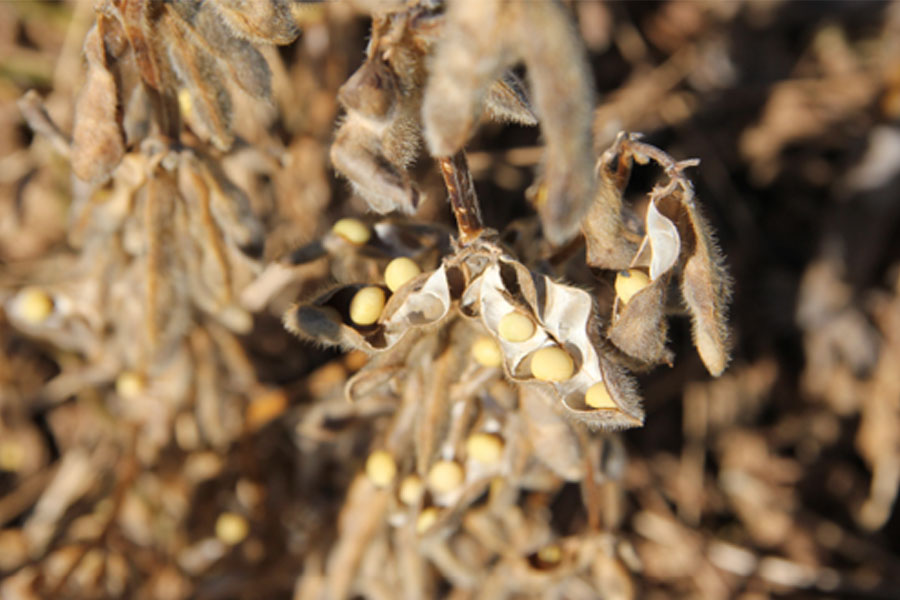What to Consider
Pod shatter in soybean can be caused by several conditions and can affect final yield. Drought conditions during pod development can result in weak pod structure. Along the length of the pod are seams on sides where the pod opens when maturity is reached. If mature pods are rehydrated after they have dried, they may open more easily. Soybean plants that were mature prior to the late rains would not have added any more weight. Instead, the seeds may have swelled, causing pods to shatter. Late season spider mite infestations can lead to premature senescence and increased pod shattering during harvest. Likewise, an early season hail event may leave twisted and empty pods at harvest. Ideally, seeds are harvested at 13% moisture content and pods will not shatter until they have matured. Shattering may occur if there is a long interval between maturation and harvest. The risk of shattering increases each day for fields which are harvested weeks after they have matured.
Yield Impact
Pre-harvest soybean pod shatter can significantly affect yield potential, especially if it begins while plants are still green. In general, a loss of four seeds per square foot equals one bushel per acre.1 Differences in various soybean products may play a role in the tolerance a plant has to shattering. Select a variety of products with relative maturities (RM) that vary by three days for every week of harvest time required for your operation. Therefore, if soybean harvest takes two weeks, it is recommended to plant three or four different maturities that vary collectively in maturity by six days or more. Preventing over-mature pods is a key way to reduce pod shatter.
Management Options
Fields should be monitored and harvested according to moisture content and combine settings should be adjusted accordingly. Soybean pod shatter loss can increase when green stem syndrome occurs as well. Waiting for a frost or stems to dry down to counter green stem syndrome may increase the risk of yield loss from pods shattering in the field during harvest. Consider harvesting fields when moisture is still at 13% moisture or higher to help reduce the amount of pod shatter. Slowing down harvest speed can reduce shatter and stubble losses. At high speeds, soybean pods can be stripped from the stem, shatter, and drop to the ground. Always refer to the manufacturer’s manual before performing any maintenance and to confirm the correct settings are being used to minimize harvest losses. Utilizing a belt draper head may also help capture more soybeans than a traditional auger system. If pod shattering has been a consistent problem in a field, soybean products should be selected for tolerance to shattering. The shattering response of a soybean product is measured after the product has been left in the field for about two weeks after maturity or about one week later than the optimum harvest time
Sources:
1 Lindsey, L. 2012. Watch out for shattering soybeans. The Ohio State University. Ohio’s Country Journal. http://ocj.com/2012/10/watch-out-for-shattering-soybeans/
2 Hanna, M. 2012. Combine settings for drought. Integrated Crop Management News. Iowa State University. www.extension.iastate.edu
3 Soybean shatter discussion. 2013. Technology Development and Agronomy. http://www.channel.com/Agronomics/Pages/Soybean-ShatterDiscussion.aspx
4 Conley, S. 2012. Drought-induced shatter of pre-harvest soybeans. University of Wisconsin. http://ipcm.wisc.edu/blog/2012/09/drought-induced-shatter/
5 Schapaugh, W.T. 1997. Selection of soybean varieties. Soybean Production Handbook. C-449. Kansas State University. http://www.harper.k-state.edu/
6 Hellevang, K. 2013. Soybean maturity, moisture variations may pose problems. North Dakota State University. www.ag.ndsu.edu/

